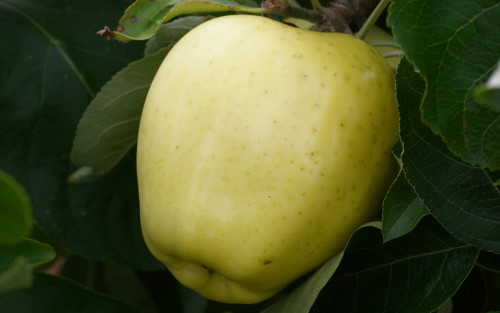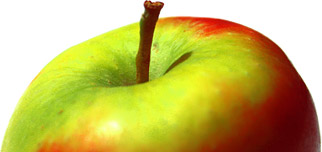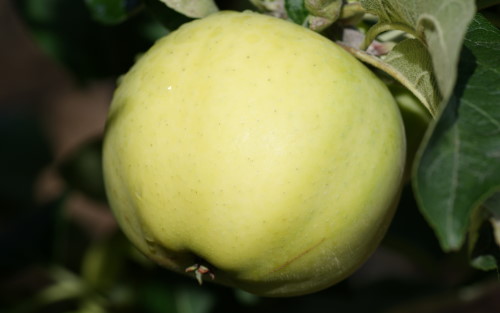
Yellow Transparent is a large early-season culinary apple, originating from Russia and quite widespread in Europe and North America. The tree is very winter-hardy.
In Europe this variety is usually known as White Transparent, and in some areas is called the Glass apple (on account of its slightly translucent skin).
Also known as
- Bely Naliv
- Saint Jean
- Transparente Blanche
- White Transparent
Yellow Transparent apple identification images
All images copyright Orange Pippin unless otherwise stated.
USDA identification images for Yellow Transparent
The identification paintings in the USDA Pomological Watercolor Collection span the years 1886 to 1942.
Citation: U.S. Department of Agriculture Pomological Watercolor Collection. Rare and Special Collections, National Agricultural Library, Beltsville, MD 20705.
Sports of this variety
Sports are natural genetic mutations of the original variety.
Visitor reviews
- 22 Sep 2023In Montana in the 1930s and 40s, it was first (by days) apple to ripen. 'Tart' as a description is misleading because we never ate it in unripe state. One day it was unripe, the next day edible, third day it was becoming translucent and inedible. We ate voraciously when there were ripe ones, and made pie and apple sauce.
- 20 Jul 2023Leave the skin on when making a pie Just made 12 and froze them
- 09 Sep 2017 MI, United StatesMy family has always enjoyed Yellow Transparent apples as pies and as frozen applesauce. I don't care for them as fresh eating apples, as it is difficult to find the right ripeness. I have to beat the squirrels to the apples, so I begin picking them before they are quite ready, but when mixed with riper apples in pies or sauce they are perfect. The apples do not keep at all, so I put them in the refrigerator immediately after picking. The sauce is so delicious, I don't care for any other kind. They ripen mid-to late-July here in the thumb of Michigan.
- 17 Feb 2017 OH, United StatesThe best apple for making applesauce. Little or no sugar needed. Once you've had applesauce from these apples it's hard to go back to applesauce in a jar.
- 23 Apr 2016 BC, CanadaEasy to grow hardy Apple. Most comments are correct- timing when best to pick to eat is important but these apples outshine all other species for applesauce! Making applesauce today has been made very simple with the tomato paste/applesauce machines available.
- 28 Feb 2016 MICHIGAN, United StatesWe have 4 of these trees. They are a great apple since they are ready to pick in late June. They are not the best tasting but certainly the earliest. They do make great apple sauce and we are going to can some this year. They are slightly bland compared to the later ripening varieties but I guess there is a trade-off.
- 14 Sep 2015 MAINE, United StatesI grew up with yellow transparent apples, and really want some now. It's been about 35 yrs since I've had one. Please can I buy some?
- 21 Aug 2015 VERMONT, United StatesI bought a piece of land in northern vermont near where I grew up with two mature yellow transparent trees, maybe 80? years old. What a blessing! They bear well every year. The first couple years I had no idea when to anticipate that crucial point of perfect ripeness. It passes so quickly, about August 20 up here in the tundra this year. I have begun to lay tarps below to cusion the drop and minimize bruising. So worth it! Also, I collect the drops twice a day- right to the fridge. The first two weeks seem to be mostly wormy apples, but once they are shed... Mine are absolutely ambrosial when still lightly? firm- give the mushy ones to the chickens!! Mine will have a small green patch around the stem and at that point the flesh is nearly white (before yellow). The yet green apples are perhaps missing half the wow. These apples dropped at the end of its harvest (fresh!) are just fantastic. The tree holds on to them just until they are perfect. If you watch them like a hawk, you will have some truly amazing eats. So good!! In the fridge, mine keep for a while. Yum!!
- 13 Feb 2015 NSW, AustraliaHad our first crop this year - 10 apples on just a small tree planted 3 years ago. Found it difficult to judge when the apples are ripe. A little too early and the apples are rather sour, a little later the apples are soft and mealy. They certainly would be fine for making apple sauce and baking, but I didn't enjoy eating them fresh.
- 17 Jan 2015 TN, United StatesThe Yellow Transparent is the one apple tree in the yard when I grew up. Mother liked them dried and we always had apple sauce. A little brown sugar and nothing else for cooking these down. It defines apple sauce for me and I have never found its equal
- 03 Sep 2014 NB, CanadaI have a roughly 100 year old Yellow Transparent tree in my backyard that was left to grow untended for several decades. Two years ago I pruned it back to pretty much a stump, and this year it produced one large, prefect, blemish-free apple. I picked it three days ago, and already today it is completely soft and mealy (inedible). If you are going to eat it, do it right off the tree.
- 13 Jul 2013 KS/SHAWNEE, United StatesI just picked my first Yellow Transparent of the season today, July 13, 2013. It's pretty bitter. I should have left it on the tree a few more days, apparently. I'll make apple crisp with it and its siblings, when I pick them.
- 26 Aug 2012 NC, United StatesThe best sauce apple I've ever tried. Good with peeling on, better with it off. at the season when it is available there is no other apple available, so it is prized as an eating apple as well, and remarkable when fully ripe for having almost transparent flesh. I know this apple only in Nova Scotia, and it certainly doesn't ship or store well. Watch it like a hawk as it ripens or the crows will consume your share as well as their own. Deer and voles love it too
- 29 Jan 2012 OR, United StatesThese are my favorite apples. I have a small tree in my yard that produces a large amount of apples. They get soft when they are ripe, but still have a great flavor. If you eat them while they are still green & firm they taste similar to a granny smith apple. Great apple for eating, apple sauce & pies.
- 20 Nov 2011 CALIFORNIA, United StatesIn the late 1940's through the 1950's this variety was grown along with about a dozen others by our neighbor in Indiana. Since it was the first variety to come on about June-July my brother and I anticipated its arrival. We often ate it way before it was ripe even when the size of a dime. We also preferred to eat it before it turned yellow and softer. Our mother baked pies with it when mature but still green and made apple sauce with it when full yellow. Big green ones were good to throw at each other.
- 03 Sep 2011 WI, United StatesI just made apple butter from this variety and it is splendid. Family loves it. I wouldn't select this for eating as it is a bit soft. Didn't travel well, which is probably why you never see it for sale. We found them at various orchards in Bayfield WI at the end of August - just beginning to come in.
Tree register
United States
- Aaron Millis in HELENA, MT
- Albany Appleguy in Castleton, NY
- Alison Loy in Burtchville, MICHIGAN / ST. CLAIR
- Axel Kratel in Santa Cruz, CALIFORNIA
- Bcarp001@Yahoo.Com in PINE CITY, MN
- Ben in Helenwood, TN
- Cody Warren in Rochester, WASHINGTON
- Dan Whitney in Cowiche, WA
- Darren Peters in Rock Spring, GEORGIA
- David A Dawson in Solsberry, INDIANA
- David Black in Bentonville, ARKANSAS
- DC Nachtrieb in Poncha Springs, COLORADO / CHAFFEE
- Dennis in Bradford, DARKE, OH
- Diane Patton in Meadville, PA
- Don Mcivor in Twisp, WA
- g Joseph Jordan in WEST CHESTER, PA
- George Brereton in Woodland, WASHINGTON
- George R in Fredericktown, PA
- Jady Morelli in Allendale, MI
- James Dierberger in Hebron, CT
- Jane Shively in NOBLESVILLE, INDIANA
- Jeff Hansen in Letcher, SD
- Jeremy And Sarah Coke in Wasilla, ALASKA
- Jerry Hilson in Everett, WASHINGTON
- Jesse in Kernersville, NC
- Joel Howie in Canton, NEW YORK
- Joel Larsen in Coloma, MICHIGAN/BERRIEN
- Karl Schmidt in Estelline, SD
- Kathy Hatch in White Heath, ILLINOIS
- Kathy Hatch in White Heath, ILLINOIS
- Kathy Hatch in White Heath, ILLINOIS
- Kelly Strand Anderson in Seattle, WA
- Kevin Sprague in Rudyard, MI
- Kristine in Tacoma, WA
- Kurt in Ladysmith, WI - WISCONSIN
- Linda Hungerford in SUMNER, IL
- Mark in Lopez Island, WA
- Menzel in Snohomish, WA
- Michael Dryfoos in EDGEWOOD, WA
- Michael Miller in Kennett Square, PA
- Michael Miller in Kennett Square, PA
- Mike Mades in Westfield, WI
- Mitch in Granger, IN
- Paul Lacasse in Brunswick, MAINE
- Peter Cox in Westford, MA
- Robert Crandall in Capac, MICHIGAN
- Robert Crandall in Capac, MICHIGAN
- Robert Wallace in WESTMINSTER, VT
- Roger Miller in Madison Heights, VA
- Sarah Martinez in Orcas Island, WA
- Shannon Champion in Buena Vista, COLORADO
- Steven Holman in Skandia, MI
- Steven Holman in Skandia, MI
- Steven Holman in Skandia, MI
- Steven Holman in Skandia, MI
- Steven Holman in Skandia, MI
- Sue Knotts in Tillamook, OREGON
- Teresa in BUFFALO, MT
- Tia Miller in VANCOUVER, WA
- Tim Cheney in Walpole, ME/LINCOLN
- William & Deborah Seale in Washington, IA
Belgium
- Johan Cornelis in Gent,
- Stijn in Gent,
Ireland
- Maurico Pipistrello in Gort, CO GALWAY
- Maurico Pipistrello in Gort, CO GALWAY
Portugal
- Luis Godinho in Sao Mamede, BATALHA
Canada
- Alex Thexton in Nanaimo, BRITISH COLUMBIA
- Clive Rose in SALT SPRING ISLAND, BRITISH COLUMBIA
- David G Anderson in Williamstown, ON
- Dina Ealey in Knowlesville, NEW BRUNSWICK
- Jason Greek in Barss Corner, NOVA SCOTIA
- Jeannine Caldbeck in Thetis Island, BRITISH COLUMBIA
- Mitch in Springhill, NS
- Mr Jean b in Ottawa, ONTARIO
- Mr Jean b in Ottawa, ONTARIO
- Phil Taber in Hampton, NB
- Stella Hiemstra in INVERARY, ONTARIO
- Will Langlands in Powell River, BC
Poland
- Richard in Krakow,
Iceland
- Sigurjon Halldorsson in Reykjavik,
Spring blossom records for this variety
2020 season
- 26th June 2020 - tree owned by Sigurjon in Reykjavik, Iceland
2018 season
- 28th May 2018 - tree owned by Steven in Skandia, United States
2016 season
- May 2016 - tree owned by Jason in Barss Corner, Canada
2015 season
- 1st May 2015 - tree owned by George in Fredericktown, United States
- April 2015 - tree owned by Kelly in Seattle, United States
2014 season
- 5th June 2014 - tree owned by Mitch in Springhill, Canada
- 11th May 2014 - tree owned by DC in Poncha Springs, United States
- May 2014 - tree owned by Steven in Skandia, United States
- May 2014 - tree owned by Don in Twisp, United States
2013 season
- 15th April 2013 - tree owned by Cody in Rochester, United States
- April 2013 - tree owned by Diane in Meadville, United States
2012 season
- 11th May 2012 - tree owned by Will in Powell River, Canada
- 15th April 2012 - tree owned by DC in Poncha Springs, United States
- April 2012 - tree owned by Johan in Gent, Belgium
- 27th March 2012 - tree owned by Jady in Allendale, United States
2011 season
- 30th April 2011 - tree owned by Jady in Allendale, United States
Record your blossom dates in our Fruit Tree Register - more >>.
Harvest records for this variety
2025 season
- 1st week July 2025 - tree owned by Dennis in Bradford, United States
2024 season
- 1st week August 2024 - tree owned by Joel in Coloma, United States
2014 season
- 4th week August 2014 - tree owned by Mitch in Springhill, Canada
- 3rd week August 2014 - tree owned by Steven in Skandia, United States
- 2nd week August 2014 - tree owned by Kathy in White Heath, United States
- 2nd week August 2014 - tree owned by Kathy in White Heath, United States
- 2nd week August 2014 - tree owned by Kathy in White Heath, United States
2013 season
- 3rd week August 2013 - tree owned by Paul in Brunswick, United States
- 3rd week July 2013 - tree owned by Cody in Rochester, United States
2012 season
- 4th week August 2012 - tree owned by Johan in Gent, Belgium
- 3rd week July 2012 - tree owned by DC in Poncha Springs, United States
2011 season
- 3rd week August 2011 - tree owned by Jady in Allendale, United States
Origins
- Species: Malus domestica - Apple
- Originates from: Russia
- Introduced: Before 1870
- UK National Fruit Collection accession: 2000-096
Identification
- Country of origin: Russia
- Period of origin: 1800 - 1849
- Popularity: Rarely grown
- Annual cycle: Deciduous
Using
- Picking season: Very early
- Keeping (of fruit): 1 week
- Flavour quality: Average
- Flavour style (apples): Sweet/Sharp
- Cooking result: Puree
- Cropping: Good
- Food uses: Eating fresh
- Food uses: Culinary
- Food uses: Traditional cooker
- Food uses: Dual purpose
- Picking period: mid-July
- Wildlife: RHS Plants for Pollinators
Growing
- Gardening skill: Beginner
- Flowering group: 2
- Pollinating others: Poor
- Ploidy: Diploid
- Vigour: Slightly large
- Precocity: Precocious
- Bearing regularity: Biennial tendency
- Fruit bearing: Spur-bearer
- Organic culture: Suitable
- Self-fertility: Partially self-fertile
Climate
- Cold hardiness (USDA): Zone 3 (-40C)
- Climate suitability: Temperate climates
- Summer average maximum temperatures: Cool ( 20-24C / 68-75F)
- Summer average maximum temperatures: Warm (25-30C / 76-85F)
- Summer average maximum temperatures: Cold (< 20C / 67F)
Other qualities
- Disease resistance: Average
- Scab (Apple and Pear): Some resistance
- Cedar apple rust: Some resistance
- Canker: Some susceptibility
- Powdery mildew: Some susceptibility
- Fire blight: Very susceptible
Where to buy trees
The following tree nurseries offer Yellow Transparent apple trees for sale:
- Orange Pippin Fruit Trees (USA) United States
Yellow Transparent apple trees - Thomas Fruit Trees (EU) France
White Transparent apple trees
Where to buy fresh fruit
The following orchards grow Yellow Transparent:
United States
Connecticut
- Country Corners Farm, Griswold
- Seek No Further Orchard, Hebron
Idaho
- BYU-Idaho Apple Orchard Museum, Rexburg
- Snake River Orchard, Rigby
Illinois
- R.E. Arends Orchard, Laura
Indiana
- Apple of His Eye, Anderson
- Dougherty Orchards, Cambridge City
- Kercher's Sunrise Orchards Farm Market, Goshen
- Harker Family Farms & Orchard, Waldron
Iowa
- Mincer Orchard & Farms, Hamburg
Kansas
- Fieldstone Enterprise, Overbrook
Maine
- Circle B Farms, Caribou
- Sweetser's Apple Barrel and Orchards, Cumberland Center
Maryland
- Blue Faerie Farm, Middletown
- Lewis Orchards and Farm Market, Cavetown
Massachusetts
- Brook Farm Orchard, Ashfield
- Red Apple Farm, Phillipston
Michigan
- Bennett's Orchard, Ottawa Lake
- Crane's U-Pick, Fennville
- Porter's Orchard Farm Market & Cider Mill, Goodrich
- Tompkins' Orchard and Country Store, Vassar
Montana
- Bluewater Orchard, Fromberg
- Ross Orchards, Fromberg
New York
Ohio
- Arrowhead Orchard, Paris
- Bauman Orchards, Rittman
- Moreland Fruit Farm, Wooster
- Wesler Orchards, New Paris
Oregon
- Beilke Family Farm, Brooks
- B&P Hitz Fruit Farm, Woodburn
Pennsylvania
- Apple Castle, New Wilmington
- Flinchbaugh's Orchard and Farm Market, Hellam
- Kauffman's Fruit Farm, Bird-in-Hand
- Miles Orchard (Miles Farm Produce), Coudersport
- Orton's Fruit Farm, North East
- Pappy's Orchard, Coopersburg
- Paulus Orchards, Dillsburg
Virginia
- Jim’s Apples, Duffield
Washington
- Piper's Orchard, Seattle
- Rosabella's Garden, Bow
Wisconsin
- Cider House of Wisconsin, McFarland
- Silver Creek Orchards, Merrill
Canada
British Columbia
- Apple Lane Orchards, Denman Island
- Blue Haze Farm, Victoria
- Dragonfly Farm, Salt Spring Island
- Fruit Forest Certified Organic Farm, Cobble Hill
- Notch Hill Organic, Sorrento
- Salt Spring Apple Company, Salt Spring Island
- Spencer Hill Orchard, Grand Forks
New Brunswick
- Verger Belliveau Orchard, Memramcook
Ontario
- O'Keefe Grange, Dobbinton
References
- Cedar-Apple Rust
Author: Stephen Vann, University of Arkansas, Division of Agriculture (FSA7538)
Rated as resistant - control only needed under high disease pressure. - Apples of England (1948)
Author: Taylor
As White Transparent


